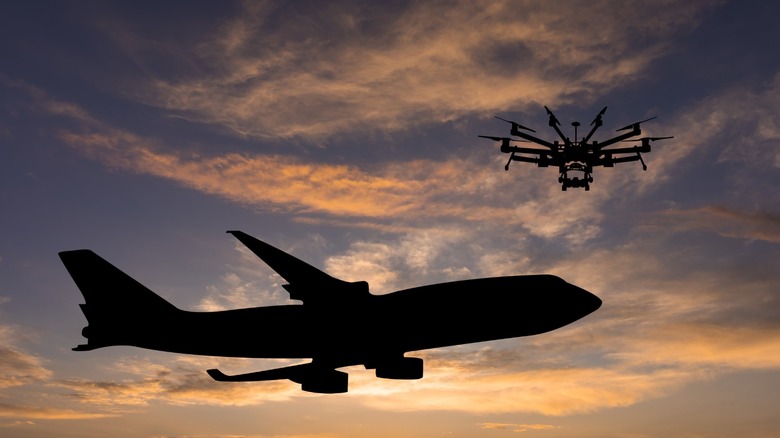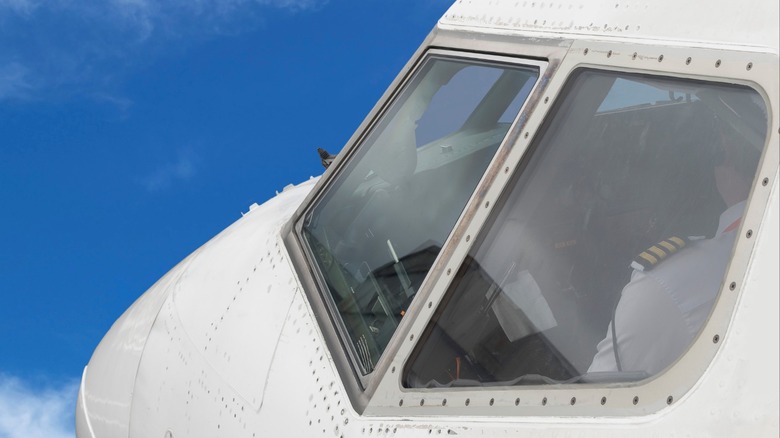What Happens If A Drone Hits A Plane? Here's The Damage It Can Do
Even though drones are relatively small and light, they can cause significant damage to an aircraft, especially if it hits a critical area during flight. Birds have already taken down a plane, as we saw with US Airways Flight 1549 in January 2009, when a flock of geese caused both of its engines to shut down and forced it to make an emergency landing on the Hudson River.
Drones are made of harder materials than birds, especially their batteries, and larger and medium-sized examples could also have around the same weight as a goose. This makes drones far more dangerous to airplanes than birds, especially if they come in contact with a plane during flight.
But what really happens when an incident like this occurs? How could something so small take down a much larger flying machine? Let's look at the kind of damage a drone can do and see how it will affect an aircraft in the air.
A drone could destroy a plane's engine
The most obvious way that a drone can take down a plane is if it gets ingested in its engine. Even though the most powerful jet engines output hundreds of thousands of pounds of thrust, these are manufactured with extreme precision and can be relatively fragile. While they're often tested to withstand bird strikes, most modern engines are not rated against drone ingestion — and researchers say that the latter results in much worse outcomes for aircraft.
One experiment used a simulation to fire an 8-pound drone into a 9-foot diameter jet engine. The results showed how the engine experienced catastrophic failure, with the fan blades ripping apart and potentially causing bits and pieces to fly out of the engine cowling, damaging the surrounding area. Another group recreated the experiment using a smaller quadcopter similar to the popular DJI Phantom 3, and the results were equally disastrous.
The threat of drones against aircraft engines isn't limited to commercial aircraft. In 2021, a single-engine propeller-driven Cessna 172, one of the most popular single-engine planes in the world, struck a drone flown by the York Regional Police in Canada. This caused major damage to the aircraft, resulting in a propeller strike, a major dent in the engine cowling, as well as damage to its airbox.
It could damage the wings of a plane and ground it
One recent high-profile incident of a drone strike happened during the Palisades Fire in early 2025, when a Canadair CL-415 SuperScooper, one of the strangest emergency vehicles ever built, was struck in the wing by a small, commercial DJI drone. This incident caused all firefighting planes in the area to be temporarily grounded, severely hampering efforts to control the fire. Aside from that, the damaged plane had to remain grounded until repairs could be made.
Research has shown that a drone hitting an airplane wing could cause substantial damage beneath the skin of the plane. Even though most drones are small, their impact speed with the aircraft could have enough energy to damage the wing spar, which is the structural unit that runs across the entire length of the wing and supports the weight of the aircraft. It could also affect other flight surfaces like the slats and flaps, which providethe additional lift necessary for the plane during low-speed phases of the flight, usually during take-off and landing.
Drones could break cockpit windows and incapacitate the pilot
The cockpit windows are some of the most vulnerable parts of an airplane, that's why most commercial airlines use specially-designed windshields to protect against bird strikes. Because of this toughness, they could also resist drone impacts, especially for smaller drones hitting larger passenger aircraft.
However, this is only applicable to airliners — smaller general aviation aircraft, like the ones you fly to get your private pilot's license, and helicopters are still vulnerable to drone damage. The worst-case scenario here is if a drone penetrates the cockpit of a smaller plane and incapacitates the pilot. Since many of these are also flown with just a single pilot, it could lead to the aircraft losing control and crashing into a populated area.
Although much smaller than even the smallest planes, drones could cause substantial damage to aircraft in flight, posing a threat to everyone in the air and on the ground. That's why you should always be aware of the rules and regulations regarding drones before purchasing and flying one.

